#african diasporic religions
Text
Tag yourself!
{made with the Ancestors and Great Spirits of the African Diaspora in mind, here's what I associate with each day of the week and the children of the diaspora born therein:
Monday's child is fair of face
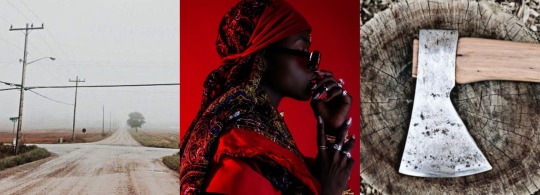
Tuesday's child is full of grace
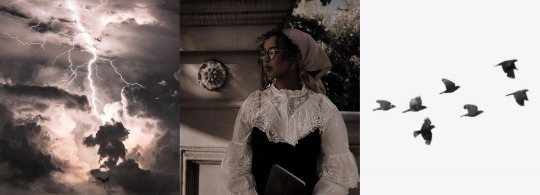
Wednesday's child is full of woe
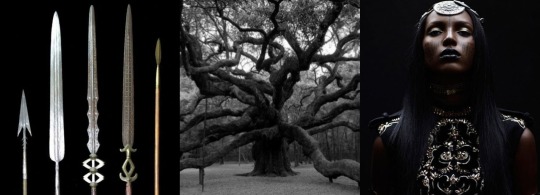
Thursday's child has far to go

Friday's child is loving and giving
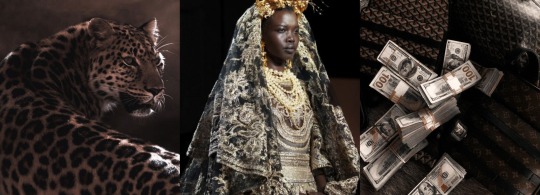
Saturday's child works hard for a living

And the child born on the Sabbath day
Is bonny and blithe, good and gay.
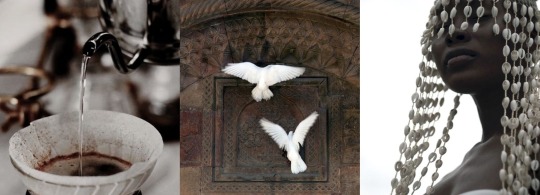
Monday: masters of finding new roads and moving forwards, tearing down blockages, trailblazers and warriors. Artists of all kinds, writers, poets, singers.
Tuesday: embodiment of thunderstorms, winds, omens, they're powerful conjurers with hot hands, always busy, always moving. Often times scholars, historians.
Wednesday: defenders, protectors, of humanity and nature as a whole. Warrior spirits at their core, but also great diviners and mediums.
Thursday: eloquent muses of the arts of love and war alike, great beauties who lead armies with equal charm and force. Sweetening, love and luck workings come easy to them.
Friday: personification of abundance and status. A commanding presence. Building legacy, great manifestors and conjurers, specially for work and finances.
Saturday: guardians of waters and the beyond. Community leaders, gifted healers, divine messengers. Carrying all the wisdom of the Elders and Ancestors.
Sunday: priests and priestesses that defy status quo, very old Ancestors coming back to reshape and rebirth reality. They will enter your life and purge every aspect of it.}
#Hoodoo#Rootwork#Conjure#Black Conjure#African american conjure#Hoodoo aesthetic#Hoodoo academia#I've had this in my drafts for so long!!!#enjoy :')#ATRs#ADRs#African Traditional Religions#African Diasporic Traditions#African Diasporic Religions#African Diaspora#afrolatine#afrolatinos
338 notes
·
View notes
Text
As African Americans, our ancestors had no other choice but to accept and embrace creativity, flexibility, innovation, cleverness, etc.. These are the building blocks of Hoodoo and AA culture as a whole. If they had practiced the same way their ancestors did in Africa, we wouldn’t have made it. If they had practiced the same way our cousins did in Cuba/Haiti/Brazil/DR/Trinidad, we wouldn’t have made it. If they had incorporated the Orishas, Lwa, Akom, or other higher spirits in Hoodoo, we wouldn’t have made it. Respect that and stop tethering these ancient deities into our spiritual system.
#hoodoo#african traditional religions#african diasporic religions#rootwork#orishas#Lwa#ancestors#african spirituality#atr#adr#santeria#orisha path#voodoo#vodun#ifa#closed religions#closed practice#adosreligion#African American culture#african diaspora#ados
127 notes
·
View notes
Text
youtube
2 notes
·
View notes
Text
I CANNOT STRESS THIS ENOUGH
Quit idolizing these mf celebrities!!!!
#atr#hoodoo#vodun#voodoo#african traditional religions#diaspora#diasporic#african diaspora#diasporic traditional religions#music
4 notes
·
View notes
Text
Y'all, "mystical" does not mean "magical." They are two different concepts.
A mystic seeks experiences beyond the apprehension of the intellect; Ecstatic experiences, direct union with divinity, the attempted acquisition of knowledge through spiritual means.
Magic is more along the lines of attempting to manipulate the world through a system of rituals and symbols.
Your average Eastern Orthodox Priest is not a mystic. An Eastern Orthodox Priest who seals himself in a cave and forgoes food so he can experience a mainline connection with god? That's a mystic.
Like, for example, many African diasporic religions have magical elements, but not necessarily mystical elements. Conversely, some Islamic groups have mystical elements, but not magical elements.
It usually varies by sect/community, and is usually an important part of what distinguishes that group from others.
3K notes
·
View notes
Note
well, why not exactly like south africa? why not like any other arab country where muslims and christians and atheists and hindus live side-by-side just fine? why not like the diverse western nations that finance your state's existence? what exactly about palestinians is so Inherently Evil And Irredeemable (bc that is honestly how you sound) that they would not have the humanity and morality to treat people like people?
it's always the same fear of the day after. white south africans are alive. white american colonisers are fucking thriving. same in australia, in new zealand. immigrants to arab countries lead entire lives there. why not like any of them?
What an exhausting, insulting question... that truly has nothing to do with anything I said. I was speaking about Hamas and leftists who support their aims to dismantle Israel, not the Palestinian people.
I have never said that it’s impossible that Muslims, Christians, Jews, (and Samaritans, Druze, etc.) will live side-by-side. They already do, in Israel. There is discrimination, but they do indeed live side-by-side. What I said was that it will not happen under Hamas rule. Which is an objective fact. The Gaza strip, by the way, is currently 98% Muslim.
I also never said that Palestinians are “inherently evil and irredeemable,” nor did I imply it. You lie in order to paint me, as an Israeli, as hateful. I am not. I spoke only of Hamas. Your conflation of a militant terrorist group with civilians is unfortunate. Hamas has proven time and time again that they do not have the humanity to treat people like people. I said nothing of the Palestinian people.
While I owe you nothing, I'll have you know that I am absolutely in favor of steps towards a peaceful solution and mutual recognition of both nations. I think it is outrageous that there are Palestinian detainees held without charge. I find the number of deaths in Gaza an unacceptable collective punishment. I am supportive of cultural and economic efforts towards reconciliation (e.g., bilingual Arab-Jewish schools and summer camps, joint activism efforts, organizations that promote dialogue and cross-cultural events, shared efforts to help victims of violence, cultural exchange and language learning initiatives). I think the current government is a disaster. I want to see a world where Jews, Christians, and Muslims—and Samaritans, Druze, and Baháʼís—live in peace together in that land. The fact that you saw me saying that Hamas would enact genocide if given the chance (which is true) and interpreted that as me saying Palestinians are “inherently evil” (which I did not say) is truly sad.
The reality is Hamas is not a resistance group. It is an Islamic ultranationalist militaristic dictatorship that has kept its citizens as prisoners by stealing international aid and running military operations to commit war crimes from under schools and hospitals. It is a terrorist group that rapes, murders, and tortures civilians, including children and infants. Peace in the region will not be possible without a demilitarized Gaza. Hamas rule is incompatible with peace. If you support Hamas, you support the violent expulsion or genocide of Israeli Jews from our homeland. You can (and should) be in support of Palestinian self-determination. This belief is also incompatible with support for Hamas. Israeli war crimes do not absolve Hamas's war crimes.
Another thing I find interesting is that you refer to a dismantled Israel as “another Arab country,” and in the same breath claim that Jews would continue to live there. I wonder, was it a coincidence that you failed to list Jews in your list of religions living side-by-side, or are you aware that there are very, very few Jews living in Arab countries today? In case you are unaware, the absence of Jews from the Arabian peninsula, the Mesopotamian region, and North Africa is a result of diasporic Jewish minorities fleeing, being expelled, and/or being ethnically cleansed. Prior to that, they lived with second class status (dhimmis) under Islamic rule. As an Israeli Jew, I cannot set foot in many Arab countries today. Is that your version of coexistence?
And let us be clear: The remaining ethnic minority groups do not live in peace in the Muslim-majority countries of the region. The examples are endless. The genocide of the Yazidis by the Islamic State. The Houthi persecution of Yemenite Jews and Baháʼís. The displaced Christians from the Syrian civil war. The Middle East is rife with examples of radicalized religious extremists being entirely incompatible with coexistence with minority groups.
Yet, in your list of co-existing religions, you picked Hinduism: a minority religion that, while practiced in some Middle Eastern countries, is not indigenous to the region. Perhaps you did this in ignorance. Perhaps it was an attempt to support your point that some immigrants and migrants can indeed lead reasonable lives in Arab countries (e.g., Indian expats in the Emirates or Saudi Arabia), as ethnic minorities with a homeland to return to. Needless to say, it's an irrelevant and feeble attempt to claim that religions currently coexist well in the Muslim-majority countries. As a whole, they do not.
Let's talk about your list of colonizers next. White South Africans being alive has nothing to do with Israel. White people thriving in the USA, Australia, and New Zealand have nothing to do with Israel. Those examples are particularly bizarre anyway, as, excepting South Africa, you’ve picked countries where the colony essentially remained in place and became the ethnic majority. But none of these colonies have anything to do with Israel, because Israel is not a colony.
Jews are indigenous to Israel. We are one of a small number of indigenous Levantine ethnic groups who call that land home. The word colony requires a context we do not have–a colony for what country? What existing country is expanding territory? We are a 4000 year old nation, many of us displaced by the Romans, and who, after 2000 years of oppression and genocide both in the diaspora and in our homeland, won our independence from the occupying force in power at the time: the British. We have nothing to do with European colonizers. You cannot colonize your own homeland.
Again, that does not mean I support the Israeli government or the IDF's actions. I fully believe Palestinians also deserve self-determination in our shared land. Our status does not change the Palestinian story. It does not undo their suffering. The situation in Gaza is untenable and an outrage. Our status does not change the inhumane conditions that Israel, along with other countries (like Egypt) have placed on the population of Gaza.
But Jews being indigenous to the region matters—because the context to understand Israel is not one of colonizer-colonized. Ours is an ethnic conflict in the context independence after a long history of many colonial powers (British, Ottoman, etc.), a wider political context of Arabization and oppression of ethnic/religious minority groups in the entire Middle East, as well as a global context of hatred of Jews and Arabs, and of Western meddling.
It also matters because it highlights the fact that Palestinians are our cousins—both because many Palestinians are likely decedents of Jews, Samaritans, etc. who were Arabized and forcibly converted Islam—but also because the Arabs are our cousins too. It is important to remember that this is an ethnic conflict, and not a situation in which one group can "go home." We have to find a way to coexist. Hamas is not that way.
Is “leading a life,” as you say, enough? Well, we wouldn't be able to, under Hamas. They have made that clear. But even if a Hamas-led state made room for dhimmi-status Jewish Israelis, then no, it would not be enough. (Remember, it is not even enough for many Palestinians who hold Israeli citizenship to live under our state with full rights.) Self-determination is important. Maintenance of language and culture is important. Statehood matters, for both Palestinians and Israelis. I do not believe we are ready for a fully unified state. Perhaps we never will be. But whatever the solution, it is imperative that both people have self-determination in their homeland.
And be it a unified democratic binational state, a single federal government with autonomous cantons/states that govern themselves, a "two states, one homeland" two state confederation, a fully-realized two state solution, or any other solution: the violent—and yes, evil—Hamas regime can play no part.
#israel palestine conflict#israel#palestine#westoid leftoids at it again#leftist antisemitism#jumblr
116 notes
·
View notes
Text
While sugarcane has defined Caribbean islands since the onset of European settler colonization, a little-known African species, guinea grass, has invaded sugar plantations from within. Cultivated to intensify sugar production, guinea grass ironically became a weed of the plantations while providing material and spiritual resources to enslaved and marooned Africans and their descendants. [...]
While sugarcane was imported from Austronesia, guinea grass hails from the western coast of Africa. Sugar was the principal crop of many Caribbean plantations; guinea grass was imported as fodder for the oxen that labored in the fields and for the cattle that fed the planters. [...]. A 1707 account by Hans Sloane, whose collections would form the core of the British Museum, describes the grass (then known as “Scotch grass”) as widespread in Barbados and Jamaica [...].
The imported grass was celebrated by eighteenth- and nineteenth-century planters for its high grazing quality. Bryan Edwards sang its praises in Jamaica, writing that it may be considered as next to the sugar-cane, in point of importance; as most of the grazing and breeding farms or pens throughout the island were originally created, and are still supported, chiefly by means of this invaluable herbage. For Edwards, guinea grass had an almost equal status to sugar cane because it could feed “the plenty of horned cattle both for the butcher and planter.” [...] By 1786, the African grass had become naturalized in Guadeloupe, and, by 1813, it had reached Mississippi, writes Parsons. It spread widely throughout Central and South America [...].
Indeed, one observer in New Granada (modern-day Colombia) was so enthusiastic as to argue that whoever had introduced the plant deserved a statue “as high as New York’s Statue of Liberty” [...].
In Cuba, the grass appears in an 1816 report of José Antonio de la Ossa, the first director of the Botanical Garden of Havana, who wrote: “It is an abundant and convenient pasture grass, because it multiplies its stalks in the same way as Sugar cane[.]”
Like Sloane and Edwards, Ossa compares guinea grass to sugarcane. The two foreign grasses seemed to them similar in morphology and function, because they both [...] promoted the economic development of the islands’ cash crop societies. [...] While sugar was introduced to Cuba long before guinea grass, it was guinea grass that allowed for the intensification of Cuban sugar cultivation with large herds of oxen.
---
Yet something strange happened in the history of this ostensibly symbiotic relationship.
Although guinea grass was meant to support the sugar economy by feeding its beasts of burden, ironically, it became a virulent weed to the sugarcane plants. By 1977, guinea grass was rated the number one weed to sugarcane in Cuba. In 2012, the journal of the National Botanical Garden of Cuba (Revista del Jardín Botánico Nacional) listed it as [...] an invasive species of greatest concern. In this way, the two imported grasses became stalky antagonists in the daily competition for light, water, and soil nutrients.
Their cultural meanings, however, had long since diverged. If sugarcane supported the economic interests of European planters, guinea grass was appropriated by enslaved and marooned Africans across the Caribbean for practical and religious purposes.
Diasporic Africans in the Virgin Islands used the dried grass to make masquerade costumes for Carnival and other festivals. In Cuba, priests used it to make omiero, [...] of the Afro-Cuban Reglá de Ochá religion.
Moreover, some of the enslaved canecutters used an ancestral West African technique to thatch their mud huts with guinea grass. [...] In fact, the famed maroon Esteban Montejo described using this method of thatching during his escape from a Cuban sugar plantation in the late nineteenth century: [...] I had never left the plantation before. I walked uphill, downhill, in every direction. [...] My feet were blistered and my hands were swollen and festering. I camped under a tree. I made myself a shelter of guinea grass in a few hours and I stayed there four or five days. [...]
Guinea grass has continued to take on new meanings for Caribbean writers in the twentieth and twenty-first centuries. In Alejandro Aguilar’s 1997 short story “Landscape of Clay,” [...] [t]he untamed grass, like the cadets’ expressions of sexuality, subverts the rigid structure of the institution. Likewise, the storyteller in the 2002 play In the Time of the Revolution by the Guadeloupean writer Maryse Condé bemoans the fact that “people’s dreams are not made to grow freely like guinea grass on the banks and highways. Some people try to pull them up, to mow them down, to dry them out, to burn them and see them go up in smoke.” [...] In undermining the economic ambitions of the plantation system, guinea grass has come to represent acts of subversion [...].
---
All text above by: Hannah Rachel Cole. “Plant of the Month: Guinea Grass.” JSTOR Daily. 1 December 2022. [Bold emphasis and some paragraph breaks/contractions added by me.]
80 notes
·
View notes
Text
Witchy PSA: Cascarilla and "Egg Cleansing"
The other day I saw a post on my dashboard about the uses of eggs in magic. The post, seemingly meant for a general audience contained two appropriative elements: the mention of cascarilla and and instructions for limpia con huevo
First, cascarilla — at least in terms of witchcraft, religion, and spirituality — is not egg shell powder. Cascarilla is the Spanish name of a sacred ritual powder originally of West African origins that found its way into Afro-Diasporic and LatAm practices via the slave trade, most notably Santería. It became known as "cascarilla" because due to a lack of access to their native plants, enslaved West Africans in what is now Cuba had to use the cascarilla plant as a replacement. Yes, some modern cascarilla powders are made from egg shells. However, to say that cascarilla = egg shell powder is similar to claiming that smudging = smoke cleansing
Egg Cleansing (or alternatively Egg Testing) was culturally appropriated from Latines. Before anyone tries arguing: Yes "Egg Cleansings" do exist in other cultures. However, the "rub an egg on yourself, crack it into a glass of water, and 'read' it method that has become the "default" over the past several years is specifically Latine. We Latines have stated countless times that our method of Egg Cleansing — limpia con huevo — is closed. Limpia con huevo is more than just rubbing an egg on yourself, cracking it into a glass of water and reading it. It is often part of a larger ritual called "limpia" involving prayers, other forms of cleansing, and even the consumption of herbal remedies and other drugs. My own mother, who is from Mexico, has memories of seeing some limpias take days to complete. Limpia con huevo has only become the "default" method of Egg Cleansing because gringos (ie non-Latine white USAmericans) appropriated it from us
tl;dr: Cascarilla is a sacred closed West African / Afro-Diasporic ritual powder, not a fancier name for eggshell powder. The "default" method of Egg Cleansing is cultural appropriation of limpia con huevo, which is for Latines only
55 notes
·
View notes
Text
Cascarilla & Efun In Your Practice + Their Uses

To day in this post I want to speak on spiritual Earth, things that are made from the earth like clay, shell, this form is used different ways. This chalk is an good tool to have in your practice.
It comes from the bark of the Croton elutaria tree that is found in the Caribbean and places like South America. Also is found in traditions of western Africa.


The concept of of this is in all West African diasporic practices including Hoodoo, Vodun/Voodoo, Santeria, Candomblé, Umbanda, Palo, and others. The word 'efun' is Yoruba translates in english meaning ‘chalk.’ In the tradition like Candomblé, efun is a ritual to initiate’s where the head and body is shaved and then decorated with tribal circles or dots (as seen above) useing chalk that was made from white clay, eggshells, or limestone powder. Some practices even use it to make a cross on there arms or on the bottom of their feet before a ritual bath.
Cascarilla & Efun: Sacred White Earth. Over time after useing the bark, other African religions such as Santeria or even in hoodoo and others in the US started using crushed powder egg shells. These were easier to get.

Cascarilla: ☝️Made from white eggshells, particularly from a Black Hen.

Efun: ☝️Efun is a white chalk that is comprised of ground snail shell and white clay.
What's Are They Really Used For. It is used for a offering Butt NOT a food offering, but an offering to deities of White meaning a of high elevated energies. (God) for example. In Africa it would be to Obatala and other high level good energies.
It's used for magical writings, painting the body during rituals, and as a medicine. In the Bantu system you have 'zumbi' other African practices like Vodou uses Zombi. (Snake deity) Or the God in the Heavens and God on earth like Nyambe/Nzambe.
("A little fact the majority of the Bantu people like others in Africa were and still are Muslim and the small percentage Christian")
Cascarilla Powder: The can be sprinkle anywhere to ward off negative energy: your home, altar, bedroom & your body. Add it to your protection powder. It’s also good to used in bath & washes, even in your divinations. I can tell you it has many uses.
Cascarilla Chalk: It can be used to make sacred symbols, magickal sigils, or veve’s and definition. (Sigils used in different Vodun/Voodoo practices). Cascarilla chalk can also be used to mark boundaries for sacred space sites or decorate sacred items.
Modern Witchcraft Uses: the power of eggshell powder has become prominent among other traditions, including Wicca. However, most non-West African diasporic traditions refer to Cascarilla simply as eggshell powder.
For Cleaning: If you want to cleanse yourself, make a mix of Florida Water & Cascarilla for a simple yet effective spiritual bath simple yet effective. (You can also add dry ingredients to it) You can also add it to a premade floor wash like the Chinese wash.
#Cascarilla uses#Efun uses#African powders#Protection chalk#Powdered chalk#spiritual#Spiritual chalk#southern hoodoo#rootwork#like and/or reblog!#google search#conjuring#traditional hoodoo#follow my blog#Voodoo#IFA#Magic powder#ask me questions#ask me anything#contact me#Teaching magic#rootwork questions#traditional rootwork#black spirituality#southern rootwork#southern conjure#new orleans voodoo
22 notes
·
View notes
Text
I was watching In Our Mother’s Garden (2021) on Netflix last night and was surprised to see Dr. Zauditu-Selassie cook for and feed the ancestors at around the 1 hour mark in what fits Dr. Brenda Marie Osbey’s description of an authentic voodoo tradition. Dr. Zauditu-Selassie explains her family of creole descent was matrilineal and “believed in Hoodoo,” though she is now a priest of Obatala in the Lucumi tradition. I understand many of the African diasporic religions share commonalities, though distinct, such as feeding the ancestors, but this is probably the closest to an authentic and respectful depiction that exists out there.
I’ve linked a list of additional resources on Lousiana Voodoo and Hoodoo here.
13 notes
·
View notes
Text
"In the framework of the national and colonial epistemologies within which Zionism imagined itself, the Arab Jews had a liminal, hybrid, and shifting status. On the one hand, they were perceived in the Zionist discourse as an integral element of the national community and as the expression of its primordial foundations. On the other hand, they were subjected to a colonial epistemology, and within this epistemology, they were orientalized and racialized. Zionism had difficulties accepting into its ranks Jews who were also Arabs. As opposed to the Palestinians, who were subjected to ethnic cleansing and Arabization (that is, were defined as Arabs rather than Palestinians), the Arab Jews had to undergo processes of 'modernization' to obscure their Arab origin. Ultimately, the success of the Zionist project was to be dependent on manufacturing these categories as antinomies (purification). De-Arabization of Arab Jews was required in order to abolish any hybridization and to perfect the dichotomy between Arabs and Jews. These practices of purification can be found most concretely in the organization of space, where the state has constructed segregated geographical spaces for Arabs and Arab Jews. Whether concrete or symbolic, these practices reduced ambivalence (hybridization) and ameliorated the threat associated with the absorption of the Arab Jews, the representatives of the Levant from within, in Israel. Thus, while multiculturalism was made possible in many societies by linking identity categories (such as African American or Irish American), this was not an option in the Israeli case. In practice, however, the ethnic or racial identification of the Arab Jews as hybrids never completely disappeared.
... It should be reminded that the state of Israel has applied similarly oppressive tactics to other Jews as well. It obliterated Yiddish as a legitimate language and condescended to Holocaust survivors on grounds of their 'diasporic mentality.' However, the category of the Arab Jews was particularly troubling, because it posed a threat to the purity of the Zionist project—as Western and modern—and to the 'great divide' that Zionism attempted to carve out between Jews and Arabs. Thus, while European Jews remained a legitimate identity category, the Arab Jews were transformed by the state and by Zionist scholars into edot ha'mizrah ('oriental communities'), a category denoting an intra-Jewish ethnic group. ... Note that the transformation of the Arab Jews into an eda constituted an act of orientalization that enabled the erasure and denial of their Arab-ness yet at the same time was still founded on the distinction between East and West. This orientalization was not only condescending and oppressive but also enticing and tempting. It carried the lure of assimilation through modernization, mixed marriages, and upward mobility. Such promise, however, was never to be fulfilled, because its fulfillment was to collapse the very East-West dichotomy upon which the Zionist discourse was structured."
Yehouda Shenhav, The Arab Jews: A Postcolonial Reading of Nationalism, Religion, and Ethnicity (2006)
16 notes
·
View notes
Text
Let's talk about San Baltasar, the Wise King, Saint of Afroargentines.
I think it's extremely interesting how one of the biggest afrodiasporic cults native to Argentina is that of El Santo Negro (the Black Saint) St. Balthazar, the Wise King. Other syncretic saint cults make mention to african deities or saints with titles such as "The Queen of Rivers" or "The Queen of the Sea", making the deities involved easily identifiable, but this cult in particular is one of the most widespread across the black population of Argentina and yet the most elusive in regards to who may be behind the mask. At least, until you pay attention to the details.
The Church first introduced the cult of Catholic Figures and Saints such as San Baltasar (King Balthazar) or San Benito de Palermo (St. Benedict of Palermo, the Moor) as a way to control the enslaved population politically and culturally. Although their goal was to dissipate african religions and install catholicism among them instead, they underestimated black argentines: after much effort, the church allowed the enslaved faithful to organize socially and politically and perform dances, drumming and singing for the saints of their formed Cofradía (similar to a congregation, but including social and political structures within it, naming a king and queen or a president and other culturally and politically significant roles). Thanks to the passing down of african culture and customs through these organized societies and the syncretism within them, we can proudly say the church failed in their attempts. The african spirits are very much still an integral part of afroargentines' lives. Today, although it has spread across the country and beyond, the center of this cult is in it's origin, the capital city of Corrientes, Argentina, in a neighborhood called Cambá Cuá.
The cult to San Baltasar is clearly african in origin, although with indigenous (guaraní) influences, such as calling the saint Santo Cambá/Kambá (Black in guaraní language), calling his statues Cambára'angá (guaraní for Black Figure), and some dancers dressing up as indigenous figures like el pombero, among other things. Thus, it is an afroindigenous cult, developing amongst mixed descendants of african enslaved peoples and guaraní natives. The cult is also a local expression of the most african of customs: ancestral veneration. The festivities honor not only the Saint himself, but all the black ancestors before us who are present in pictures at the altar, and answer to the call of the drums. The color red, that covers the saint and adorns his followers, is the color of warriors and protection in African Traditional Religions. He's offered food and drink (such as wine and traditionally made sangría), and most importantly dance and drums. He is invoked and honored, along with the ancestors, through drumming and dancing, through La llamada a San Baltasar and Saludos de Tambores a los Santos Cambá (Calling Saint Balthazar and Drum Salutations to the Black Saints).
His festivities, held in Corrientes around Epiphany, from January 1st to the 6th, include dancing afroargentinean rhythms such as diverse forms of candombe and samba. Particularly, he was traditionally honored with a dance called bambula, a form of ring dance where women move in short and slow steps, barely lifting their feet, while men jump in the air, and where one singer sings a phrase that is then repeated or answered by the others present. This kind of dance is native to Congo and Angola, and widely practiced by enslaved people and their descendants in the Southern United States, the Caribbean, Brazil, Argentina and Uruguay. The music used to this day to petition favors, to invoke his spirit into his image and even dispel or call thunderstorms or other natural phenomena, is called charanda and includes drums, guitars and triangles. Just like in other afrodiasporic devotional and resistance dances, these dances involve Kings and Queens of the dance, a hierarchy of drummers including those called Master drummers, and a hierarchy of the drums themselves as Chico, Repique and Piano.
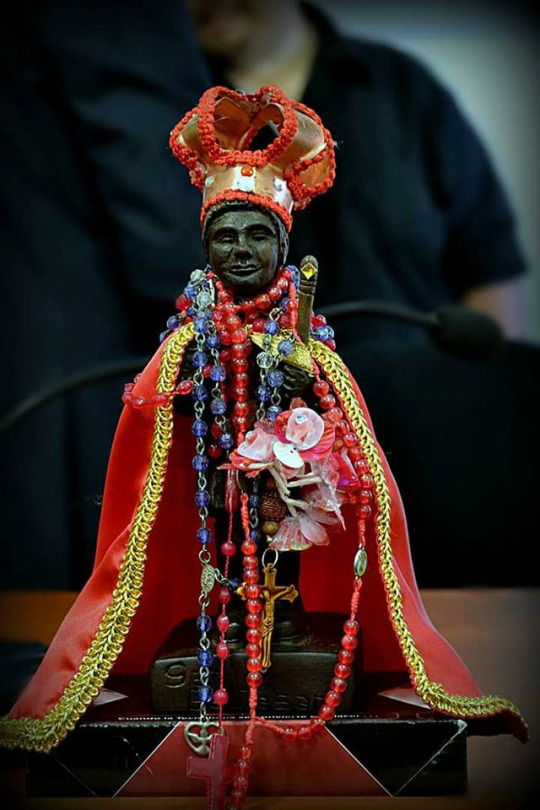
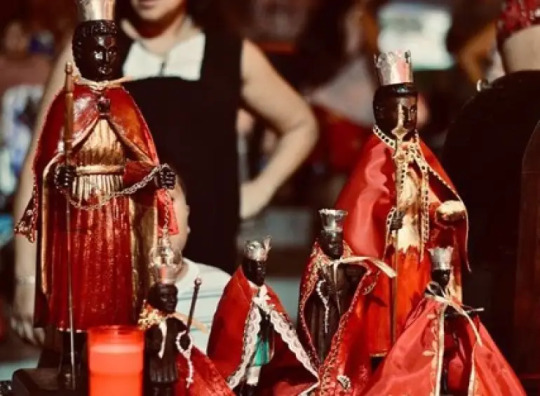
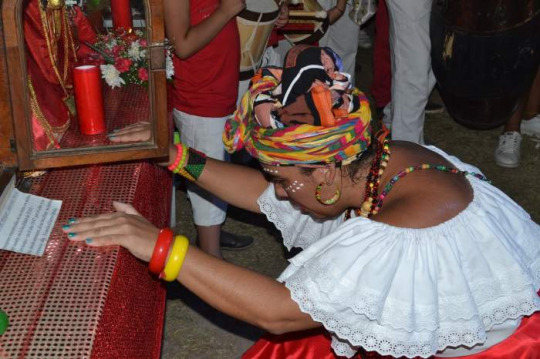


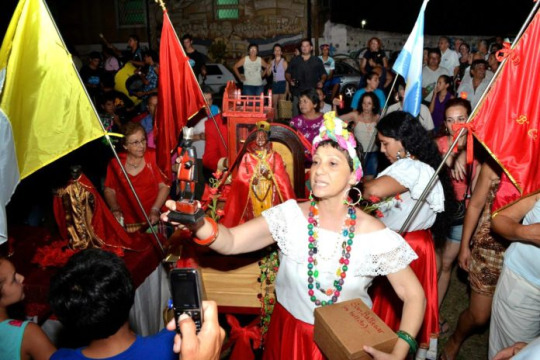
If you compare him to Xangó...
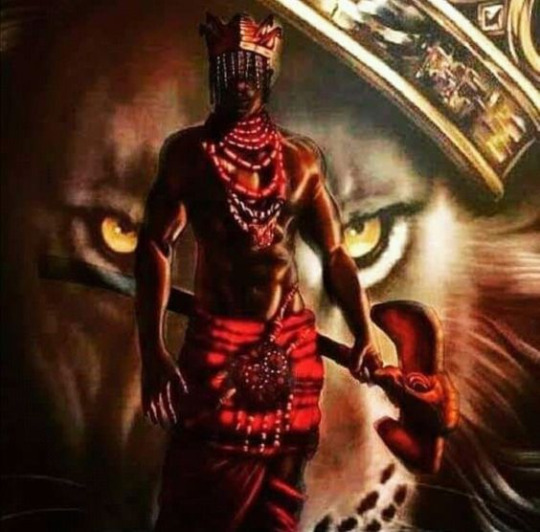
He carries a double-headed axe. He's often depicted wearing a crown. His colors are, surprisingly, also white and red, with gold accents. Also a King and a warrior, also associated with thunderstorms and fire, drums and dance. His followers also wear white and red beaded collares. Ringing any bells...?
Now, I am not saying they are the same Spirit, but there is an undeniable resemblance. You come to your own conclusions. It's kind of obvious that this afrodiasporic cult stems from either (a) a hidden, veiled cult to the orisha(s) or (b) a syncretic cult to african deities (not only orishas but maybe other african spirits too). There is, after all, strong ties not only to Yorubaland but also to Dahomey, Kongo, etc. Just in this instance, the spirit may resemble an orisha but the rhythms and dance are from kongo, so there is much more to it than just one or the other. There is a culture of resistance born from the union of Nations through music, faith and tradition.
Sources:
None of the images here belong to me: San Baltazar and festivities [1,2,3,4-6] and Xangó [1]
Festividad de San Baltasar : performances artístico-religiosas de la cofradía de la ciudad de Corrientes, by Cavalieri, Ana Belén, Universidad Nacional del Nordeste. Facultad de Artes, Diseño y Ciencias de la Cultura, 2018. Available for download at [Link]
San Baltazar, Historias de Corrientes at [Link]
The bamboula Lineage at [Link]
The Orishas, Indiana University at [Link]
#ATRs#afroargentina#afroargentines#afrolatine#afrolatinx#afrolatino#black saint#black saints#st balthazar#st. Balthazar#San Baltazar#Santería#shangó#xangó#santeria#african diaspora#african traditional religions#african diasporic religions#african diaspora religions#ADRs#san baltasar
20 notes
·
View notes
Text
To the world, sincerely, a tired black artists and my fellow creatives
A lot of the weird demonization of Rema’s visuals really made me sad. I’m not surprised at the lack of cultural knowledge about Edo people and Benin City, Nigeria — virtually everywhere outside of the continent, African history, culture and traditions aren’t taught unless you are in special programs or majors. But to call something demonic and satanic because you don’t understand? The blatant xenophobia and racism has me so furious. I know we have a lot of unlearning to do, but I had imagined that the colonial ways of viewing black Africans was not alive and thriving amongst the diaspora. To see so many black Christian’s come together in the name of their white gods and forced religion to call something so sentimental, historically important and significant for Rema and many others demonic is like having a weird ‘dejavu’.
Everyday I think about how I see too many people complain about lack of representation of black people from all around the world in media; wether it be movies, tv, fiction, music genre and other industries predominantly white — and now, given visuals and such cool performance, we do as our oppressors once did. Word for word. It’s disgusting and I hope everybody who partook educated themselves and do better.
When will my people know peace when it comes to trying to share, showcase and be proud of what we’ve created? I never forgot how Fufu became a laughing stock, how so many still mock their parents pronunciations knowing that’s their third of even fourth language. And don’t let me start on Nollywood or the diasporic movie industries — why must you laugh when you don’t understand? Question things, yes, be curious and explore. But mocking?
To all my fellow Africans and black people of the diaspora— one day, we will be in a world where we’re known for more then our struggles. Where were not mocked for our ‘incorrect’ speech of languages violently forced upon us, that we adapted to fit who we are and our origins. One day we will have peace; no more silent genocides, or loud ones. No more having to hide our roots, traditions, practices, art/creations. Be ashamed of any aspects of our culture that does not warrant shame.
I ask that if you want representation, you seek it out because trust me it is out there. The continent has so many creations — sure some harder to find or consume due to language barriers but we all witnessed K-drama’s boom. You can watch French, Spanish and English films — so why are subtitles not good enough when it’s in Igbo? Xhosa? Wolof? Zulu? Bafang?
I ask that everybody, including myself, start to give africa it’s flowers. The more we pour into the good — art, creations, industries etc that inspire more to create and expand, the more we will see the uprise of what has always been within the continent but never given much thought by most of the world because it is African and the quality is regarded as ‘lesser’.
And I hope I get to witness more great artist come from all around the motherland, and be part amongst them when I eventually complete my African/Black centered work ✌🏾
#upload#thoughts#africa#rema#African culture#west africa#rant#xenophobia#pray for the world#pray for Congo
20 notes
·
View notes
Note
Hi, weird question maybe, I'm just some guy who stumbled on your quora answers and figured you're pretty knowledgeable. I'm Italian and I'm wondering if you knew of any forms of magic that could be compared to what in Italy is referred to as 'low ceremonial magic', usually practiced by farmers / poor people. I'm looking for similar traditions in other parts of the world because I'm trying to figure out what kind of magic is most practiced by low income people historically. Thanks a lot
Great question! I'm still in the process of learning about "low magic" or "folk magic." I usually call it folk magic, to distinguish it from ceremonial magic, although the lines between the two are pretty thin and there's significant overlap. (The difference seems to be mainly a class distinction.) If you want to research it, I recommend using "folk magic" as your keyword.
My own country, the United States, has several robust traditions of folk magic that tend to go unnoticed by people who aren't in contact with them. Appalachian Magic is one of the big ones, and Southern Conjure is another one of the big ones. New England has its own variant of English "cunning." Hoodoo and Rootwork are both African diasporic traditions, based in Vodou and practiced mainly in the South. There's also "Pow-Wow," which is mainly Pensylvannia Dutch, Curanderismo and Brujeria (Hispanic), various magical traditions that stem from indigenous religions, and the extremely popular New Age variant of folk magic (which is apparently called "manifesting"). I'm not intimately familiar with all of these systems, but I highly recommend reading New World Witchery by Cory Thomas Hutcheson for a primer on North American folk magic.
The one I know the most about is English "cunning." I just did a project for which I translated part of Bald's Leechbook, a medieval book of herbal remedies written in Old English that was intermixed with some folk spells. I've observed that folk magic tends to be very Catholic, or Catholic-syncretic, because Catholicism has a lot of folk-magic stuff built right into it (like saints' medallions and votive offerings) that were intentionally rooted out of Protestantism. But hey, new folk traditions are always popping up all the time. Tarot cards are only about two hundred years old, but they're a valid and effective divination method, and you can find them in any mainstream bookstore these days.
Finally, I feel the need to say that folk magic is very dark. There's a common idea, mainly in New Age and neopagan circles, that your spells will rebound on you if they're unethical. This has no historical grounding. Curses, forceful love spells, bindings, and other baneful spells are really common. Frequently, magic was the only source of power or agency for people with no other options. Sanitizing folk magic does it a disservice. That doesn't mean that you have to practice baneful magic, only that you should understand why it exists and respect it.
#folk magic#folk witchcraft#witchblr#witchcraft#history of magic#occultism#occult#folklore#folk spellcraft
17 notes
·
View notes
Note
Since you know a lot about the occult, I wanted to ask you what you know about Haitian vodou
I know the broad strokes of Haitian history and it's relationship to vodou, but beyond that, relatively little. African diasporic religions have been historically underrepresented in scholarship, but that's actually been changing recently! If you're interested, I'd reccomend Vodou in the Haitian Experience: A Black Atlantic Perspective.
335 notes
·
View notes
Text

Published in September, 2023:
Tales of the Orishas is a fantasy-adventure graphic novel that explores Afro-Brazilian legends and mythology.
Tales of the Orishas fuses the pantheon of the African diasporic religion of Candomblé with the Silver Age comic aesthetics of Jack Kirby into a riveting tale of high adventure. The story centers around a celestial battle between the gods of Brazil, who are worshipped by the Bahia people, and a fearsome conquering force led by a dark and malevolent overlord. Only Shango, the god of fire and thunder, can lead his people into victory while the fate of creation hangs in the balance.
"In ancient times, when heaven and Earth were united as two halves of a gourd, deities and heroes walked among men. They fought battles with fury and taught the ways of the ashe (the energy of creation), land, iron, and fire. They reigned and loved with great intensity. Some descended from the luminous Orun, to live their lives and fulfill their destinies, while others were born in the aiye, and through their great deeds became Orishas, changing forever the history of two continents."
Masterfully executed and painstakingly researched, writer and artist Hugo Canuto brings these legends to life with incredible designs and a vibrant color palette. Tales of the Orishas is a bright and brilliant story that showcases mythology as a powerful tool to remind us that there is something greater to unite the peoples who sail on the blue star called Earth.
34 notes
·
View notes